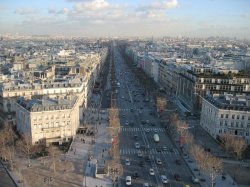Online Encyclopedia
Champs-Élysées

The Champs-Élysées (pronounced /ʃɑ̃zelize/, IPA; /SA~ ze.liz.e/, X-SAMPA; literally the "Elysian fields") is a broad avenue in the French capital Paris. With its cinemas, cafés, and luxury specialty shops, the Champs-Élysées is one of the most famous streets in the world. The name refers to the Elysian Fields, the kingdom of the dead in Greek mythology.
| Contents |
Description
The avenue runs 3 km through the Censored page in northwestern Paris, from the Place de la Concorde in the east with its obelisk to the Place Charles de Gaulle (formerly the Place de l'Étoile) in the west, location of the Arc de Triomphe, and forms part of the line of the Axe historique.
One of the principal tourist destinations in Paris, the lower part of the Champs-Élysées is bordered by green space (Marigny Square ) and by such buildings as the Théâtre Marigny and the Grand Palais (comprising the Palais de la Découverte ). The Élysée Palace is a little bit to the north, not on the avenue itself. Farther up to the west, it is lined by cinemas, theaters, cafés and restaurants (most notably Fouquet's ), and luxury specialty shops.
History
The Champs-Élysées were originally fields and market gardens, until 1616, when Marie de Medici decided to extend the garden axis of the Palais des Tuileries with an avenue of trees. As late as 1716, Guillaume de L'Isle's map shows that a short stretch of roads and fields and market garden plots still separated the grand axe of the Tuileries gardens from the planted "Avenue des Thuilleries", which was punctuated by a circular basin where the Rond Point stands today, already with some planted avenues radiating from it that led to the river through woods and fields. In 1724, the Tuileries garden axis and the avenue were connected and extended, leading beyond the Place de l'Étoile; the "Elysian Fields" were open parkland flanking it, soon filled in with bosquets of trees formally planted in straight rank and file. To the east the unloved and neglected "Vieux Louvre" (as it is called on the maps), still hemmed in by buildings, was not part of the axis. In a map of 1724, the Grande Avenue des Champs-Elisée stretches west from a newly-cleared Place du Pont Tournant soon to be renamed for Louis XV and now the Place de la Concorde.
By the late 1700s, the Champs-Elysées had become a fashionable avenue; the bosquet plantings on either side had thickened enough to be given formal rectangular glades (cabinets de verdure). The gardens of houses built along the Faubourg St-Honoré backed onto the formal bosquets. The grandest of them was the Élysée Palace. A semi-circle of housefronts defined the north side of the Rond Point. Queen Marie Antoinette drove with her friends and took music lessons at the grand Hôtel de Crillon on the Place Louis XV. The avenue from the Rond Point to the Etoile was built up during the Empire. The Champs-Élysées itself became city property in 1828, and footpaths, fountains, and gas lighting were added. Over the years, the avenue has undergone numerous transitions, most recently in 1993, when the sidewalks were widened.
Commerce
In 1860, the merchants along the avenue joined together to form the Syndicat d'Initiative et de Défense des Champs-Élysées, changed to an association in 1916 headed by Louis Vuitton to promote the avenue. In 1980, the group changed its name to the Comité des Champs-Élysées. It is the oldest standing committee in Paris. The committee has always dedicated itself to seek public projects to enhance the avenue's luxe atmosphere, and to lobby the authorities for extended business hours. Even today, the committee has approval over the addition of new business to the avenue.
Because of the high rents, few people actually live on the Champs-Élysées; the upper storeys tend to be occupied by offices. Rents are particularly high on the north side of the avenue, because of better exposure to sunlight. The splendid architecture of the grandiose "Champs-Elysées" is admired by many people. It is located right next to the Presidential palace with its rounded gate and the "Grand palais" that was erected in the late 19th century. While walking among the gardens and tree- lined promenades one could even encounter an open- air marionette theatre for children - a French tradition popular with the ages.
Events
Every year on Bastille Day, the largest military parade in France passes down the Champs-Élysées, reviewed by the President of the Republic. The Champs-Élysées is also the traditional end of the last stage of the Tour de France.
External links
- Avenue des Champs-Elysées http://www.insecula.com/salle/MS01196.html/
- Barry Bergdoll, Columbia University: Paris maps http://www.columbia.edu/cu/arthistory/courses/parismaps/
